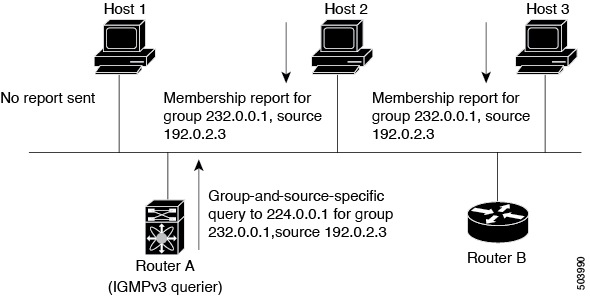About IGMP
IGMP is an IPv4 protocol that a host uses to request multicast data for a particular group. Using the information obtained through IGMP, the software maintains a list of multicast group or channel memberships on a per-interface basis. The systems that receive these IGMP packets send multicast data that they receive for requested groups or channels out the network segment of the known receivers.
By default, the IGMP process is running. You cannot enable IGMP manually on an interface. IGMP is automatically enabled when you perform one of the following configuration tasks on an interface:
-
Enable PIM
-
Statically bind a local multicast group
IGMP Versions
The device supports IGMPv2 and IGMPv3, and IGMPv1 report reception.
By default, the software enables IGMPv2 when it starts the IGMP process. You can enable IGMPv3 on interfaces where you want its capabilities.
IGMPv3 includes the following key changes from IGMPv2:
-
Hosts no longer perform report suppression, which means that hosts always send IGMP membership reports when an IGMP query message is received.
 Note |
The Cisco Nexus® 3550-T switches does not support SSM. |
For detailed information about IGMPv2, see RFC 2236.
For detailed information about IGMPv3, see RFC 5790.
IGMP Basics
This figure shows the basic IGMP process of a router that discovers multicast hosts. Hosts 1, 2, and 3 send unsolicited IGMP membership report messages to initiate receiving multicast data for a group or channel.

In the figure below, router A, which is the IGMP designated querier on the subnet, sends query messages to the all-hosts multicast group at 224.0.0.1 periodically to discover whether any hosts want to receive multicast data. You can configure the group membership timeout value that the router uses to determine that no members of a group or source exist on the subnet.
The software elects a router as the IGMP querier on a subnet if it has the lowest IP address. As long as a router continues to receive query messages from a router with a lower IP address, it resets a timer that is based on its querier timeout value. If the querier timer of a router expires, it becomes the designated querier. If that router later receives a host query message from a router with a lower IP address, it drops its role as the designated querier and sets its querier timer again.
In this figure, host 1’s membership report is suppressed, and host 2 sends its membership report for group 224.1.1.1 first. Host 1 receives the report from host 2. Because only one membership report per group needs to be sent to the router, other hosts suppress their reports to reduce network traffic. Each host waits for a random time interval to avoid sending reports at the same time. You can configure the query maximum response time parameter to control the interval in which hosts randomize their responses.
 Note |
IGMPv1 and IGMPv2 membership report suppression occurs only on hosts that are connected to the same port. |
In this figure, router A sends the IGMPv3 group-and-source-specific query to the LAN. Hosts 2 and 3 respond to the query with membership reports that indicate that they want to receive data from the advertised group and source.

 Note |
IGMPv3 hosts do not perform IGMP membership report suppression. |
Messages sent by the designated querier have a time-to-live (TTL) value of 1, which means that the messages are not forwarded by the directly connected routers on the subnet. You can configure the frequency and number of query messages sent specifically for IGMP startup, and you can configure a short query interval at startup so that the group state is established as quickly as possible. Although usually unnecessary, you can tune the query interval used after startup to a value that balances the responsiveness to host group membership messages and the traffic created on the network.
 Caution |
Changing the query interval can severely impact multicast forwarding. |
When a multicast host leaves a group, a host that runs IGMPv2 or later sends an IGMP leave message. To check if this host is the last host to leave the group, the software sends an IGMP query message and starts a timer that you can configure called the last member query response interval. If no reports are received before the timer expires, the software removes the group state. The router continues to send multicast traffic for a group until its state is removed.
You can configure a robustness value to compensate for packet loss on a congested network. The robustness value is used by the IGMP software to determine the number of times to send messages.
Link local addresses in the range 224.0.0.0/24 are reserved by the Internet Assigned Numbers Authority (IANA). Network protocols on a local network segment use these addresses; routers do not forward these addresses because they have a TTL of 1. By default, the IGMP process sends membership reports only for nonlink local addresses, but you can configure the software to send reports for link local addresses.
 Feedback
Feedback